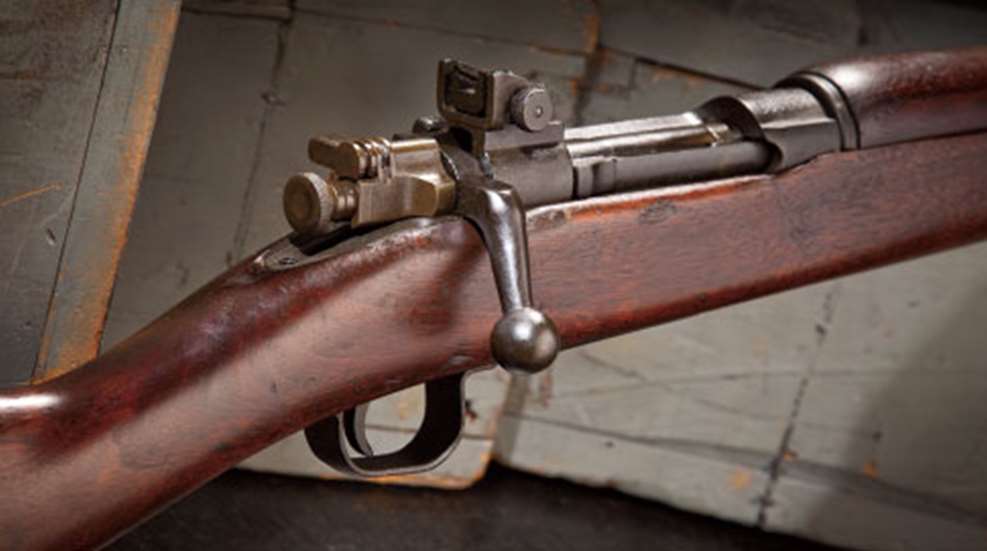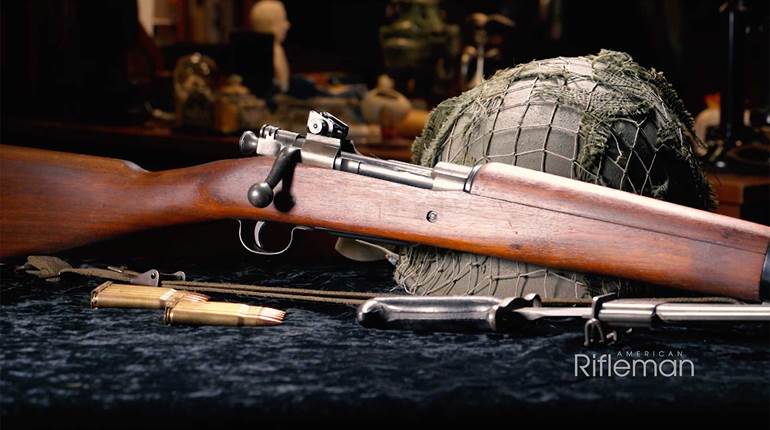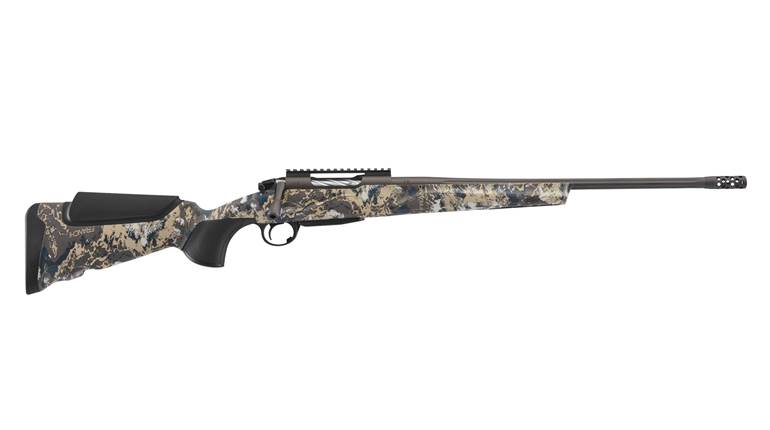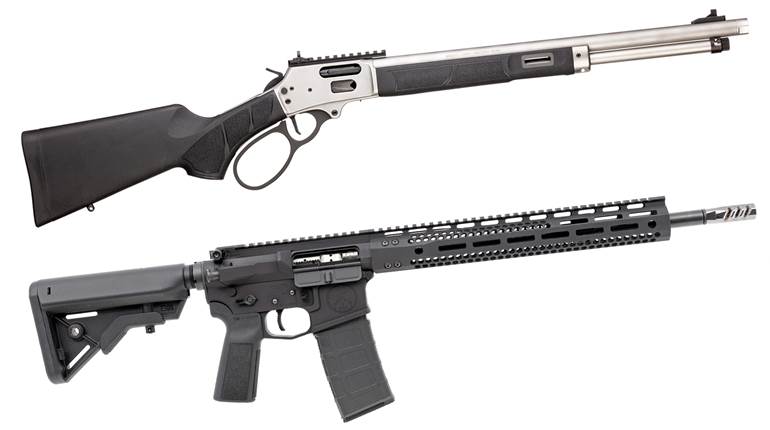
On the eve of America’s active involvement in World War II, it was apparent that there would be a serious shortage of service rifles for its rapidly expanding armed forces. Plans were made to increase M1 rifle production at Springfield Armory, and the Winchester Repeating Arms Co. was granted a production contract for the Garand. Even with this increase in M1 rifle output, the anticipated supply of service rifles would be insufficient to meet the demand. Existing Model 1903 Springfield rifles in the government’s inventory, along with substantial numbers of obsolescent but serviceable Model 1917 rifles, were taken from storage and reconditioned as necessary for issue. Even so, it was apparent that more rifles would be needed. To this end, in 1941 the U.S. Army Ordnance Dept. contracted with the Remington Arms Co. for new production of the Model 1903 bolt-action rifle using machinery and some raw materials (mainly stock blanks) in storage at Rock Island Arsenal since manufacture of the ’03 rifle ceased at that entity in the early 1920s.
Remington began manufacture of Model 1903 rifles in fall 1941. Initially, the new Remington ’03s were very similar to the rifles made at Rock Island Arsenal in the late World War I period. Shortly after Remington started its new ’03 production line, America was officially at war with the Axis powers, and the expected huge demand for more rifles became a stark reality. Remington sought to increase production by reducing cosmetic touches such as careful polishing of the metal prior to Parkerizing and eliminating some non-essential features. By early 1942 the company had made some 649 changes in ’03 manufacture to speed production and reduce costs. While these changes were marginally helpful, further modifications of the basic design were deemed necessary. These changes included less machining to the rear sight fixed base, elimination of the bolt stop, replacement of some milled parts with stamped, sheet metal components and elimination of the grasping grooves on the rifle’s stock.
As demand continued to escalate, Remington received more ’03 production contracts and continued to consider ways to further increase the manufacturing rate. One component that remained more or less unchanged from the earlier M1903 rifles was the Model 1905 rear sight. This sight, and its barrel-mounted fixed base, required a great deal of machining. A simplified receiver-mounted rear sight would reduce production time and have the added bonus of being a better combat sight.
These changes were significant enough to warrant a new “model” designation and, on May 21, 1942, the “U.S. Rifle, Caliber .30, Model of 1903A3” was standardized. Shortly thereafter Remington began updating its tooling and equipment to accommodate the changes required for production of the new rifle. The first Remington M1903A3 rifles were delivered in December 1942.
While Remington was struggling with increasing its production rate, the Ordnance Dept. sought other manufacturing sources for new ’03 production. To this end, in January 1942 the Ordnance Dept. began negotiations with High Standard Mfg. Co. of New Haven, Conn., for the production of 100,000 ’03 rifles. High Standard was interested in the contract, but it was already operating at near peak capacity with existing contracts and would be unable to serve as prime contractor on the new project. The company offered to accept the contract if it would be permitted to manufacture only the barrels and subcontract the rest of the production, including assembly of the rifles, to the L.C. Smith & Corona Typewriter Co. of Syracuse, N.Y. The Ordnance Dept. was reluctant to agree to such a proposal and, logically, took the position that Smith-Corona should be named prime contractor with High Standard serving as the subcontractor for barrel production. Since the Smith-Corona factory was in relatively close proximity to the Remington plant, it was believed that the latter would be able to assist the new manufacturer with the technical aspects of rifle production. All parties concurred with the proposal and on Feb. 25, 1942, Smith-Corona was granted a contract for M1903 rifle production.
While Smith-Corona was in the process of procuring the necessary manufacturing equipment, the M1903A3 rifle superseded the M1903. Accordingly, in May 1942 Smith-Corona’s contract was modified to substitute the M1903A3 for the M1903 rifle. Concurrently, the original contract for 100,000 rifles was increased to 380,000. The first “pilot” batch of 20 Smith-Corona M1903A3 rifles was completed in October 1942, and mass production began in November, a month ahead of Remington’s initial delivery of ’03A3 rifles. Production slowly increased, and by December 1942, Smith-Corona had manufactured 5,540 ’03A3s. As had been the case with Remington, some problems with procurement of rear sights from subcontractors resulted in the delay of initial deliveries. Eventually that problem was resolved and sufficient quantities of the sights were procured, and increasing numbers of ’03A3s began to flow from the Syracuse plant. Other than the manufacturer’s name on the receiver ring, the Smith-Corona ’03A3 rifles were quite similar to those made by Remington, but differed in some minor aspects. The salient features of the Smith-Corona M1903A3 rifle were: The receiver ring had the same marking format as the Remington rifles except for the name of the manufacturer, “U.S./Smith-Corona”; and Smith-Corona was assigned two distinct “blocks” of serial numbers: 3,608,000 — 3,707,999 and 4,708,000 — 4,992,000.
Interestingly, Remington “over ran” some of Smith-Corona’s first block of serial numbers. Consequently, there were an estimated 3,600 Remington ’03A3 rifles produced with numbers initially assigned to, and used by, Smith-Corona. The receivers with these duplicate numbers were stamped with a “C” next to the serial number for identification and inventory control purposes.
The barrels were marked “SC” and the month/year of barrel production. Reportedly, very early in production, High Standard (the maker of the barrels) acquired some unfinished barrel “blanks” from Savage Arms Co. These had six grooves and were initially produced for commercial rifles before being diverted to the ’03A3 production program. High Standard completed the machining of the barrels and marked them “SC” along with the month and year of manufacture. The Ordnance Dept. granted the company a waiver for use of these non-standard barrels as their utilization would permit High Standard to deliver barrels to Smith-Corona sooner than would otherwise have been possible. The number of six-groove barrels used in Smith-Corona ’03A3 production is estimated to be about 5,000. After using up the six-groove barrel blanks, High Standard began manufacture of four-groove barrels, which were used for the balance of production except for a few two-groove barrels that were used for about a one- or two-month period in late 1943. Regardless, the majority of Smith-Corona rifles had four-groove barrels.
Although nearly identical in configuration, there are several rather subtle differences between the Smith-Corona and Remington stocks. For example, the Remington ’03A3 rifles were stamped with a 7/16-inch “circled P” proof firing mark on the bottom of the grip (behind the trigger guard) while the Smith-Corona rifles had a 1/2-inch proof stamp in this same location.
Another minor difference was the configuration of the recess for the spring on the lower barrel band. The recess on the Smith-Corona stocks had a rounded profile while the Remington stocks had a square profile. The final inspection marking format stamped on the left side of the stock was similar to the type found on the Remington ’03A3s but lacked the “RA” (Remington Arms) mark.
The only substantive difference between Remington and Smith-Corona bolts was that the Remington bolts were marked “R” at the root of the handle while the Smith-Corona bolts were usually marked with an “X” on top of the bolt handle, although some unmarked examples can be found. Any bolt found on a Smith-Corona rifle, other than one marked “X” on top of the bolt handle, or unmarked, is a replacement and not a factory original component. Some extractors found on original Smith-Corona bolts were marked “S” on the bottom. Also, the Smith-Corona bolts had a distinctive “scalloped” profile to the sleeve and safety lug. Some of the bolt sleeves were marked “G.” Like the Remington ’03A3s, original Smith-Corona bolts were blued. Many rifles can be found today with Parkerized bolts, which indicate that the components were refinished, typically as part of a post-World War II Ordnance Dept. overhaul.
Smith-Corona and Remington rifles used the same type of stamped sheet metal furniture, including barrel bands, band springs, screws, pins, floorplate/magazine assemblies, and buttplates. Most of these parts were originally blued although a few components made later in production, such as upper bands, may have been Parkerized. Model ’03A3s, either Remington or Smith-Corona, found with all-Parkerized furniture can be safely assumed to have been overhauled. Unlike some Remington parts, which were stamped “R,” the majority of Smith-Corona parts were unmarked, although a few marked “G” have been observed. Therefore, it should be remembered that factory-original Smith-Corona rifles will not have any “R”-marked parts. Any such parts on a Smith-Corona ’03A3 encountered today were installed at some point after the rifle left the factory, again, normally as part of an arsenal rebuild.
Another difference between Remington and Smith-Corona rifles was the checkering pattern on the buttplates. Remington buttplates had 16 “squares” to the inch while Smith-Corona buttplates had 10 or 11 “squares” per inch. Also different was the configuration of the stamped and welded trigger guard/magazine assembly behind the front screw hole. The Remington component has a straight profile whereas the Smith-Corona part has a semi-circular indention.
As the war progressed and production caught up with demand, Smith-Corona’s production contract was cancelled on Feb. 19, 1944, by which time the firm had manufactured 234,580 M1903A3s. Remington continued production slightly longer but its ’03A3 rifle contract was cancelled on Feb. 28, 1944, after the company had produced 707,629 ’03A3 rifles.
The Remington and Smith-Corona M1903A3 rifles provided yeoman-like service to U.S. armed forces during World War II. Although not used for overseas combat duty in the same numbers as M1 rifles, or even the earlier M1903 variants, some M1903A3 rifles did, in fact, see action. Numerous World War II vintage photos depict ’03A3 rifles employed in overseas combat zones. Military Police (MPs) and other ostensibly non-combat military personnel were issued M1903A3 rifles, but they were also employed by front-line combat infantrymen. Model ’03A3 rifles were used in combat in virtually all theaters of the war, including the European, Mediterranean, and China-Burma-India (C-B-I). Large numbers were also utilized for stateside training and for supplementary use by sentries and other personnel. Despite the shortcuts employed in the manufacture, the M1903A3 rifles were every bit as serviceable as the better-finished earlier production rifles.
The ’03A3s had strong nickel steel receivers, and the rear sights were actually better for combat use than the older M1905-pattern sights. M1903A3 rifles are among the most common variant of the ’03 available to collectors, and examples can usually be found without too much difficulty, although prices for pristine examples are steadily rising.
After the conclusion of World War II, some of the M1903A3 rifles were sent to various and sundry foreign nations. In addition, large numbers were shipped to various ordnance facilities for inspection and overhaul prior to being placed in long-term storage, typically after being coated in cosmoline. Although most had previously been arsenal-overhauled before being placed into storage, some were never issued and remained in factory-new condition. It is normally easy to differentiate between a rifle remaining in its factory configuration and one that has been overhauled. The rebuilt examples can be identified by the arsenal rebuild stamps on the stock, the presence of parts with mixed contractor codes and Parkerized furniture (including bolts).
It is sometimes forgotten that America’s true secret weapon of World War II was its awesome industrial might. Civilian firms that had never produced war material or arms were soon turning out vast quantities of desperately needed items with which to fight the war. There are myriad examples of this industrial versatility, not the least of which was the service rifle made by a typewriter company.





































